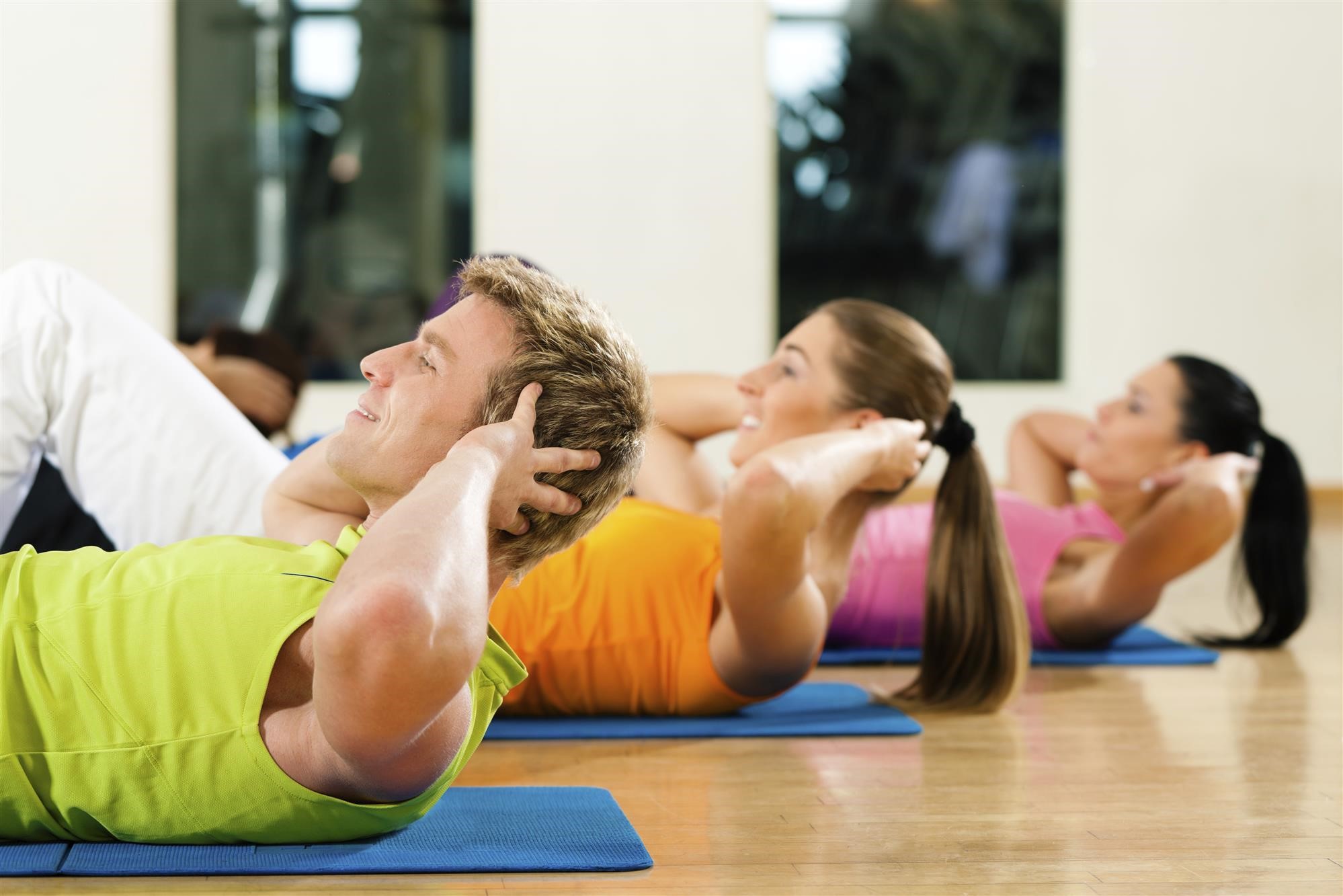Exercising Your Core Muscles Without Damaging Your Pelvic Floor
 “Push, ladies, push!” exclaims your group exercise instructor. Your high-octane “core fusion” circuit training class is especially intense this week. You hear others in your class grunting and gulping for air behind the sound of pulsating music.
“Push, ladies, push!” exclaims your group exercise instructor. Your high-octane “core fusion” circuit training class is especially intense this week. You hear others in your class grunting and gulping for air behind the sound of pulsating music.
“One more set!” your instructor hollers.
Your abdominals sting with each crunch until it’s almost unbearable, but your instructor’s voice keeps you focused and motivates you to push through and finish the last agonizing set.
“FIVE, FOUR, THREE, TWO, ONE, and DONE! Good job, ladies” your instructor praises.
You lie on the (now soaking wet) hardwood floor of the workout room, thankful it’s over and letting the endorphins wash over you. “I kicked butt,” you think to yourself. You know your abs are going to be sore tomorrow, but core muscles always seem to recover quickly from an intense workout, you tell yourself.
The problem: Without realizing it, you could be causing damage to another set of muscles—those of the pelvic floor—with every intense core workout session. We’ll explore this and other issues ahead. First, let’s define the pelvic floor.
What Is the Pelvic Floor?
Located deep in the pelvis, the pelvic floor is made up of muscles, ligaments, and connective tissues that support the bladder, bowel, and uterus. Weak pelvic floor muscles can lead to urinary incontinence (UI), a common but underreported problem in women.
Life events such as pregnancy, childbirth, menopause, and certain surgeries can increase a woman’s risk of pelvic floor muscle damage during intense abdominal exercise, as the muscles may already have sustained damage or become weakened from past trauma.
Urinary Incontinence (UI): A Silent Nuisance
Leaking a few drops or even a stream of urine isn’t something most women are comfortable talking about, yet it’s something quite a few women experience. We don’t hear much about urinary incontinence in the media, either, save for the occasional incident involving a music superstar or Olympic athlete.
Whether it’s a few drops of urine that slip out from a laugh, cough, or sneeze (stress incontinence) or feeling a sudden, intense urge to go (urge incontinence), most women don’t realize how common UI actually is. Millions of women—30 percent, in fact—will experience urinary incontinence at some point in their lives. Half of those women will never talk with their doctor about the issue. This is unfortunate, since many forms of UI can be effectively addressed with regular pelvic floor exercise, aided by a supportive Kegel biofeedback device.
Core strength is important, but overdoing core exercises can cause collateral damage to the pelvic floor—especially if you’re at high risk. Let’s delve deeper into the anatomy of the core muscles and uncover how to exercise them gently but effectively.
The Core: Our Body’s Strength Center
Core muscles are vital for balance and stability. The core is not limited to the muscles you can see around the stomach (what we often think of as the “six-pack” region). In fact, dozens of muscle groups make up the core, including:
- Pelvic floor muscle
- Obliques (which run along the trunk)
- Rectus abdominis (the “six-pack” muscles)
- Multifidi (deep back muscles)
- Diaphragm
- Transverse abdominis (located underneath the external and internal obliques)
- Gluteus maximus (butt muscles)
All of these muscle groups work in concert to keep us balanced. Over focusing on one particular area (such as the abdominals, by doing loads of crunches) can be counterproductive and lead to injury by creating imbalanced muscles.
While the larger “global” muscles of the core create big movement patterns, the smaller, deeper core muscles connect vertebrae from one joint to another. A solid core exercise routine should work all of the muscle groups—large and small, without causing strain that can lead to pelvic organ prolapse (more on that below). Let’s look at some of these exercises.
The Problem with Traditional Abdominal Exercises
 Traditional sit-ups and crunches tend to put excessive pressure on the abdominal cavity, which can strain the pelvic floor and lead to prolapse (dropping) of the bladder, uterus, or other organs in the pelvic region.
Traditional sit-ups and crunches tend to put excessive pressure on the abdominal cavity, which can strain the pelvic floor and lead to prolapse (dropping) of the bladder, uterus, or other organs in the pelvic region.
When the bladder (for example) drops from its normal position, it can push against the walls of the vagina, in turn preventing the urethra from closing completely. This can lead to urine leakage (urinary incontinence).
Squeezing your core muscles intensely from the middle (as with crunches, curls, and sit-ups) puts pressure on your organs. To visualize, imagine squeezing a tube of toothpaste from the middle—apply too much pressure and, eventually, toothpaste may burst out through both ends of the tube. Similarly, putting excessive pressure on the abdomen can squeeze and displace internal organs, leading to prolapse over time.
The key is to engage your core muscles internally—rather than externally—to prevent prolapse and urinary incontinence. The difference between internal core exercising opposed to external core exercising is the impact on the pelvic floor. Practicing intense abdominal exercises can cause excess intra-abdominal (internal) pressure, which does not allow you to breathe properly, such as a corset. This in result can increase the risk of pelvic floor injury. Cease strong abdominal exercises to reduce impact on the pelvic floor and exercise your abdomen gently with core exercises listed below.
“The pelvic floor could be that missing link in a woman’s running workouts, core training, Pilates or sports performance,” states Mary Drill, Fitness Expert and owner for Body Mechanics by Drill. “Women don’t realize that their abs could look better and be stronger with the help of their pelvic floor. Doing pelvic floor exercises correctly and consistently can have a very positive impact.”
Safe Core Exercises for Your Pelvic Floor
Circumstances that put women at high risk of pelvic organ prolapse with intense abdominal exercise include:
- Recent pregnancy or childbirth
- Menopause
- Being overweight or obese
- Recent surgery (including hysterectomy, prolapse surgery, and others)
If you are at risk for pelvic floor injury, it’s important to avoid exercises that cause excessive stress on the upper abdominal muscles. Avoid sit-ups, crunches, and floor exercises where both legs are raised off the floor at once. Here are safe abdominal exercises, and those to avoid.
Safe Ab Exercises
 Modified Plank: On hands and knees, extend your left leg back and your right arm forward and then bring back to center. Repeat 10 times. Switch leg/arm and repeat 10 times.
Modified Plank: On hands and knees, extend your left leg back and your right arm forward and then bring back to center. Repeat 10 times. Switch leg/arm and repeat 10 times.- Diaphragm Breathing Exercise: Diaphragmatic breathing helps strengthen the entire core. Lie on your back with knees bent and hands resting on lower abdomen. Exhale, expelling all your air, then slowly inhale until your lungs are full. Repeat 10 times.
- Clamshell: Lay on your side with knees bent and your head propped up by one arm. Raise your outer leg, hold for a few seconds, and then lower. This position engages your obliques and abs gently. Do several sets of 10 reps.
- Kegels: With or without a Kegel exercise device, Kegel exercises are the ideal way to exercise your pelvic floor—part of your core. You can do Kegels sitting, standing, or lying down, although if you’re using a pelvic floor exerciser you’ll need to be lying down. Contract your muscles as though you’re stopping the flow of urine. Hold for five seconds and repeat. Aim for five minutes of Kegels every day. The bonus: Kegels can enhance sexual experience and lead to more intense orgasms.

- Modified double leg raises: Double leg raises are popular in Pilates and floor exercise classes, but they put a lot of strain on the pelvic area. Modify the move by raising only one leg and keeping the head and shoulders in constant contact with the floor. Repeat 10 times with each leg, and don’t forget to breathe normally throughout.
- Squats: Stand upright with feet shoulder-width apart. Keep the heels firmly on the ground, and with back straight, bend at the waist, then the knees as it you’re about to sit down into a chair. Don’t lean forward as you squat; rather, “sit down” into it. Move up and down slowly, and do at least two sets of 10 reps.
Ab Exercises to Avoid if at High Risk
The following exercises have a high pelvic floor load and should be avoided:
- Traditional sit-ups, curls, and crunches
- Ab exercises with a medicine ball
- V-sit
- Plank exercises (e.g., “hovers” and push-ups, done on hands and feet)
- “Hundreds” (lying down with both legs and head raised, and pumping arms up and down in small motions 100 times, or some variation thereof)
A good rule of thumb is to keep at least one leg and your head on the floor when doing ab exercises on your back.

Core exercises are an important part of any fitness routine, and women at any age or stage of life can and should do core strengthening exercises—the key is not overdoing it, recognizing when you’re at a higher risk of developing pelvic floor injuries, and modifying exercises accordingly.
And talk to your doctor about getting a PeriCoach pelvic floor exerciser right away!


